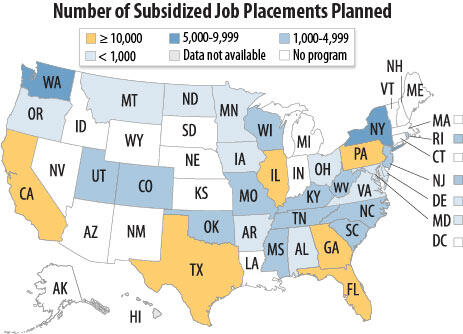BEYOND THE NUMBERS
I’ve been calling the TANF Emergency Fund the Recovery Act’s best-kept secret, but the secret is out — just ask the nearly 200,000* adults and youth who will get jobs through one of the many subsidized jobs programs the fund supports across the country (see map). The Senate is considering jobs legislation that would extend the fund (which expires September 30) for a year and fully offset the cost. This may be the last chance for congressional action before both the fund and most of those jobs disappear.
If the Senate doesn’t pass a jobs bill with this provision, many states will begin to wind down their programs as early as next week and most programs will end altogether by September 30.

Here’s what’s at stake:
- The program in Illinois — one of 30-odd states to use the Emergency Fund for temporary jobs programs — has placed 14,000 people in jobs paying $10 an hour since it started just a few months ago and is now placing more than 500 a day. The placements are in a mix of private businesses, nonprofits, and government agencies. It’s a win-win for people seeking jobs and employers seeking workers.
- Mississippi, building on its initial success of engaging 1,200 unemployed people in its program, has created two new programs — one providing summer jobs to youth ages 18-24 and one helping low-income entrepreneurs start a business — that will bring the total number helped to 3,500 by the end of September.
- San Francisco has placed more than 3,000 people in subsidized jobs, far above its original goal of 1,000. To meet the needs of a diverse group of individuals while controlling costs, San Francisco triages participants into one of three tiers, offering intensive personal support to those who wouldn’t succeed without it (such as the homeless), modest support to those with limited work experience, and minimal support to those who have simply fallen on hard economic times.
- Oklahoma officials and participating employers have praised the program for serving a critical need with minimal red tape. The state expects to place 900 people in jobs by the end of September. Thus far, 85 percent of the workers whose four-month subsidized job has ended have remained with their employers, who have taken over the full costs of maintaining them on the payroll.
The TANF Emergency Fund provides just what is needed in this sluggish economy with very high unemployment: jobs at a very low cost. Because the jobs are mostly entry-level positions, the wage and payroll costs are quite low; creating a $10-an-hour job for 40 hours per week costs under $500 per week or under $3,000 for six weeks, the typical length of a subsidized job. Administrative costs also are low because many states have been able to operate these programs by building on existing job placement programs.
The House has already voted — twice — to extend the fund. But if the Senate doesn’t act, most of the people who’ve gotten work through the program will soon become unemployed. That would be a terrible loss, and a preventable one.
* Update, June 29, 2010: This post has been modified to reflect current data.
